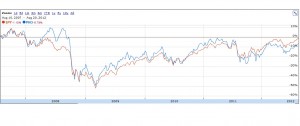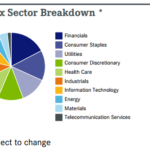Like life insurance to a newly-wedded couple, water ETFs are supposedly the best investment in the world. Water is a scarce resource – some 780 million people go without clean water every day of the week.  Not a day goes by that we don’t read about water-borne illnesses in the developing world, drought conditions in the US driving up food prices globally, fires, climate change and all other manners of water-related crises.
So why have water ETFs performed so poorly? If clean, potable water is in such short supply, it should make investors boatloads of money, right?
Here’s a chart that shows water ETF versus the S&P 500 index:
(click to enlarge)
The performance looks pretty much the same (slight loss to SPY actually) over 5 years.
Water ETFs are Anything But!
Exchange-traded funds occasionally fall off the wagon. Issuers get so excited to bring a new sector ETF to the market that they miss out on what’s important: what the ETF actually holds.
The PowerShares Water Resource Portfolio (PHO) holds only a fraction of its portfolio in true water stocks. The vast majority is in real estate positions for utilities and water sanitizing companies. The ETF would be more accurately described as a utility REIT, because it is real estate, not water, that the company invests the majority of its assets under management.
The same is also true of the PowerShares Global Water Portfolio (PIO), which has roughly the same weakness – limited water exposure – with the only differentiator being that PIO holds global resource real estate stocks.  And it’s down 25% over the prior 5 year period.
The S&P Global Water Index (CGW) fund holds far more global water companies, but the largest holdings are in the water infrastructure business. Building new water mains is an entirely different business than cleaning water for human consumption. The supply of industrial and base metals is hardly affected by increased water use. Â CGW dpes no better, turning in a 7% loss over the prior 5 year period.
Why Water Stocks Won’t Outperform
Let’s look at some of the headwinds that affect a commodity industry:
- Regulation – Anyone who has ever listened to a utility’s conference call knows that prices for the end product (gas or electricity) is strictly regulated by local governments. Simply put, if there is any margin in selling natural gas and electricity, you can bet that politicians will stick their hands in the kitty. The same is true of water – usually only one provider services a geographic area, which brings regulation.
- High capital expenditures– Utilities are not a cheap business to run. Water pipes are neither inexpensive to install, nor inexpensive to maintain. Additionally, much of the cash flow generated by any utility is used to buy new capital expenditures that are necessary to continuing operations. When businesses report earnings in the form of more water treatment plants, water lines, or even new coal power plants, only a handful of cash can be returned to owners.
- It’s a commodity! – Businesses cannot add value to a commodity. The term “commodity†literally means that the product or service is the same from place to place. Nike can slap a swoosh on a pair of shoes to increase profit margins. You cannot slap a logo on water to sell it at a higher price.
- No pure plays – Water stocks as a pure-play do not exist. It is only natural that the companies in the water business are either managed by municipalities, or involved in other businesses like trash disposal or electricity and gas sales. One of the few ways to improve margins in the utilities space is to cut costs – combining administrative costs from multiple service providers is one of the easiest. In short, pure-plays do not exist – you’re buying utilities, not water.
- Miserable fees – Water ETFs on the market have incredibly high fees for undiversified funds with a small number of holdings. PowerShares Water Resource Portfolio (PHO) charges .60% per year, the Claymore S&P Global Water Index (CGW) grabs .65% annually, and the PowerShares Global Water Portfolio (PIO) wants .75% of assets each year. That’s a lot to pay for market-matching performance.
If anything, water ETFs are simply over-marketed funds that will likely keep pace with the broad market and be net losers in the end due to the fee structure (see the 5 lowest cost ETFs on earth to maximize total passive returns). To those of us who have never feared a day without clean water, water seems like an incredible opportunity here and abroad. The problem, however, is that water is not scarce; only clean water is in short supply. As long as water is a regulated, competitive, and capital intensive commodity product, investors won’t get much better returns than they would in a broad market index.
The best way to make money in the water industry might just be selling ETFs “designed” to track it.











{ 0 comments… add one now }